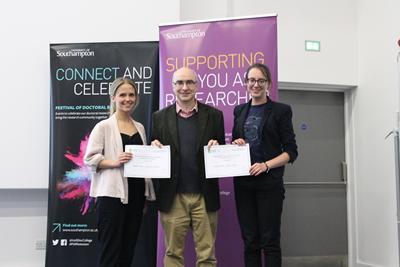Environmental engineer awarded Three Minute Thesis prize for applying deep learning to the deep sea

Postgraduate research student Jenny Walker impressed in the Southampton Three Minute Thesis (3MT®) Grand Final with a novel approach of using machine learning to monitor ocean environments.
The Southampton Marine and Maritime Institute researcher tied an audience vote to share the event’s People’s Choice Award with overall winner Gabriela Sitinova.
The pair enthralled a packed lecture theatre with impactful three-minute PhD presentations at the Grand Final, part of the University Doctoral College’s three-week Festival of Doctoral Research.
“I'm amazed to have made it this far and so flattered that I was one of the audience's favourites,” Jenny says. “It's really reassuring, at the halfway mark through my PhD, to have such strong public support for the work that I'm doing. This competition has really boosted my confidence and motivation for scientific outreach.”
Jenny is using machine learning to segment images of the seafloor, with a view to eventually extracting data such as estimated biomass and biodiversity indexes from the images.
The Leverhulme Trust Doctoral Scholar has also been recently recognised with a Student Poster Competition prize at the International Symposium on Underwater Technology in Kaohsiung, Taiwan.
“The oceans contain a huge portion of life on earth and their health is a key indicator to the health of the global ecosystem,” Jenny explains. “There's a serious lack of research into how to adapt deep learning systems, developed for big data problems with thousands of labelled data points, to the smaller, specific problem domain of deep sea imagery. I hope my research will provide a springboard for many researchers after me into this vastly unknown field.”
University 3MT Champion Gabriela Sitinova is exploring new methods of inserting and studying atoms within a spherical Buckminsterfullerene molecule, or ‘buckyball’.
“Single atoms or molecules encapsulated inside these C60 fullerenes have spectacular physical and chemical properties,” she explains. “We have so far optimised our methods of known compounds and recently published novel fullerene CH4@C60, which is the largest molecule placed inside to date. I hope that desired molecules will soon be produced on a large scale thanks to our methods and that their properties will be utilised in cancer diagnosis and novel superconducting materials.”
The 3MT success completed a profitable week for Gabriela in which she also gained a second place poster prize in a Doctoral Research Showcase.
“This competition has helped me realise how much I love what I’m doing and I’m thrilled that the judges and audience have appreciated it,” Gabriela says. “It’s a really fun process to think how to communicate your research in a way that is understandable and interesting to a non-scientific audience and the whole competition has helped me overcome my fear of talking in front of people.”